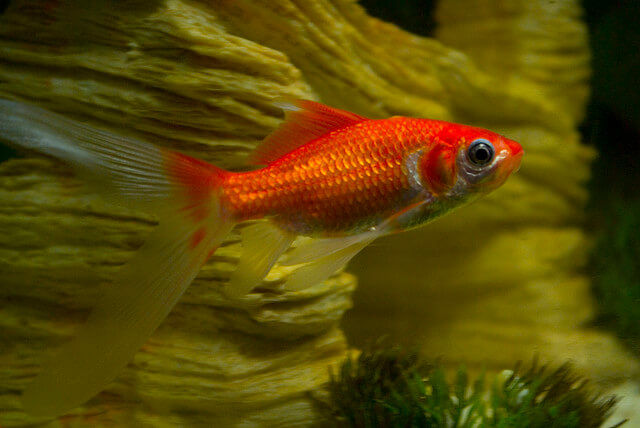The Comet Goldfish is a popular and visually striking breed that originated in the late 1800s in the state of Washington, United States. This particular goldfish species has gained significant popularity due to its vibrant color variations and graceful appearance. In this article, we will explore the unique characteristics of the Comet Goldfish and provide insights into its care requirements.

Distinctive Variations and Coloration
The Comet Goldfish exhibits several variations, with the orange metallic comet being the most well-known and widely sought-after. Its bright orange color stands out beautifully in goldfish ponds. Additionally, there are other stunning variations, such as the red and silver sarassa comet, which display captivating calico patterns. These patterns can range from combinations of red and white to black and orange, yellow, red, black, and the classic goldfish orange.
Physical Characteristics
While the Comet Goldfish shares similarities with the common goldfish, it possesses distinct physical attributes. Its body is more slender, elongated, and streamlined. The most notable feature of the Comet Goldfish is its elongated caudal fin, which extends more than half to three-quarters the size of its body. The caudal fin is characterized by pointed ends, setting it apart from the common goldfish. Additionally, the Comet Goldfish has two pectoral fins and pelvic fins, while its dorsal fin, anal fin, and caudal fin are single.
Housing Requirements and Tank Size
When considering the care of Comet Goldfish, it is crucial to provide them with adequate space. As these fish can grow up to 12 inches long (30.48 cm), they require a minimum tank size of 55 gallons (208 liters). If possible, a pond setup would be ideal, as it allows the Comet Goldfish to exhibit their graceful swimming behavior. The larger space also helps maintain water quality and stability.
Water Quality and Maintenance
To ensure the well-being of Comet Goldfish, maintaining good water quality is paramount. A well-maintained filtration system is necessary to keep the water clean and free from toxins. Regular water changes are also crucial in order to remove accumulated waste and maintain optimal water conditions. Testing the water parameters regularly and addressing any imbalances promptly will help promote the health of the fish.
Diet and Nutrition
Comet Goldfish are omnivorous, meaning they consume both plant and animal matter. While they will eat various foods, providing a balanced and varied diet is essential for their overall health. High-quality commercial fish food specifically formulated for goldfish should constitute the staple of their diet. Additionally, offering a variety of vegetables, such as peas and lettuce, can provide necessary fiber. Live or frozen food, such as bloodworms or brine shrimp, can be given occasionally as a treat to add dietary diversity.
Compatibility with Other Fish
Comet Goldfish are social creatures and can coexist peacefully with other fish species, as long as they are similar in size and temperament. It is important to avoid keeping them with aggressive fish, as this can lead to stress and increased susceptibility to diseases. Choosing compatible tankmates, such as other goldfish breeds or peaceful community fish, will ensure a harmonious aquatic environment.
Lifespan
With proper care and attention, Comet Goldfish can live for over a decade, providing long-lasting beauty and enjoyment to their owners. Their vibrant colors, graceful movements, and unique physical characteristics make them a captivating addition to any aquarium or pond.
Conclusion
The Comet Goldfish is a visually striking and graceful breed that has captured the hearts of fish enthusiasts worldwide. With their vibrant color variations, slender bodies, and elongated fins, they stand out among other goldfish species. Providing them with suitable housing, good water quality
Reviewed By: Tim Winter

Tim Winter has a strong affection for pets and wildlife. His years of experience caring for various types of pets has led him to share his knowledge with others on the best practices in pet care. Tim holds a Bachelor of Science from the University of Oregon School of Journalism and Communications.
